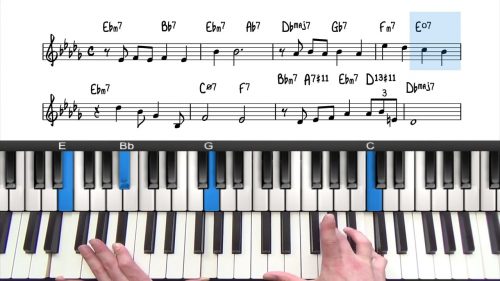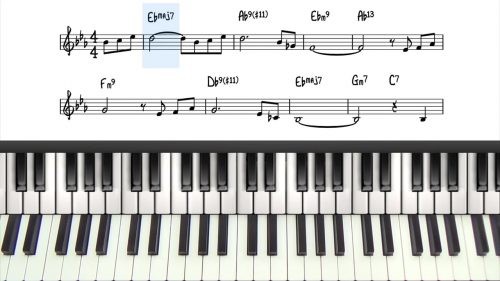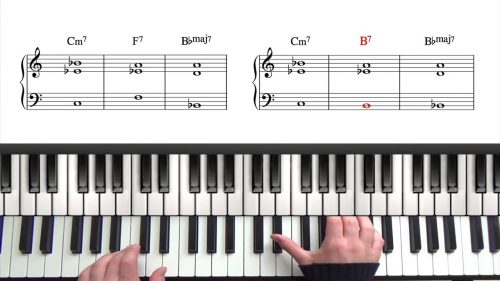Rhythm Changes Explained
In this masterclass we’re going to talk about Rhythm Changes. In jazz, Rhythm Changes is a very common form and is used as the basic framework for many well-known and commonly-played tunes. It’s very popular in jam sessions and a crucial part of everyone’s piano repertoire.
The Origins Of Rhythm Changes
Rhythm Changes is a chord progression that is based on a Gershwin song ‘I Got Rhythm’. In the early bebop days musicians became fond of the chord progression and the possibilities, and while performing the actual song ‘I Got Rhythm’, they also started writing their own songs over the chord progression.
The Progression & Contrafacts
This type of composing where you take a chord progression from another song and write your own melody over is called a contrafact, or commonly called a head. I recommend to check out as many contrafacts over Rhythm Changes as you can. Here are few popular ones:
- "Anthropology" by Charlie Parker
- "Rhythm-a-ning" by Thelonious Monk
- "Oleo" by Sonny Rollins
"I Got Rhythm" by George Gershwin
Now a few words about the actual song "I Got Rhythm". As I mentioned earlier, it is written by George Gershwin, and lyrics by his brother Ira Gershwin, and published in 1930.
The tune follows an AABA form, with 2 bar extension in the last A. However, this 2 bar extension is most likely omitted when playing the Rhythm Changes, or when playing a contrafact of this progression.
"I Got Rhythm" is usually played in the key of Bb, although originally it was written in the key of Db, and the solo piano versions I’ve heard played by Gershwin himself have a modulation to F.
Lesson Downloads
-
Rhythm Changes Chord Progression File Type: pdf
Practice Tips
-
When learning jazz, Rhythm Changes and the 12 Bar Blues are thought of being the two most important chord progressions to learn and play in all keys.
-
I would recommend to take the two very seriously, listen tons of songs written over them, transcribe from them and practice the progression until you have committed it to your memory.
-
For easy transposition, it's important that you understand the numeric construction of the form.
-
The A Sections are usually 1-6-2-5-1 or 3-6-2-5, then 25 to 4, #4 diminished, and finally 3-6-2-5 which takes you back to the start.
-
The B Section or Bridge is a chain of dominants starting from the 3. In the key of Bb we have D7(3), G7(6), C7(2), and F7(5) leading to the top of the last A.
- There are numerous variations of the rhythm changes, depending on the era of jazz it is performed, so in this lesson we're going to be showing the most common ones.








Hi Tuomo
Just a couple questions about diminished chords. Likely it was covered elsewhere on the site, but I don’t fully understand all the ways a diminished chord resolves to the next chord.
If its a dim 6 scale, the two halves of the scale are I6/V7b9. (C E G A/D F Ab B). So I just understand no matter what the inversion, if you play the chords diatonically up the scale on a dim sixth chord, its always I/V I/V, etc. That’s easy to understand.
In Rhythm I don’t understand:
At 3:15 the Edim goes to C-7. E G Bb Db to C Eb G Bb. The Edim is neither the dominant to the C-7 nor the F7. I don’t understand that relationship and why it works.
At 6:18, I fully get that the B dim is a V7 to C-7, and C#dim is the V7 to D-7.
At 11:21, the Edim goes to 3-6/2-5. Edim to D-7 is E G Bb Db to D F A C. Edim is dominant if its C7b9 to F6 if I’m looking at as a dim 6 chord,
But if the D-7 is aeolian, how do you really look at the 3-6? The key is Bb, but the 3 – 6 is really C. The 2-5 is Bb.
To digress, in jazz blues I also don’t understand why the dim in the sixth bar resolves to the tonic, like in an F blues when the B dim resolves to F7. B D F Ab to F A C Eb.
This is just all the ways diminished harmony gets me confused, and one reason I find rhythm changes difficult. I don’t really want to gloss this over, like “you’re thinking to hard”.
Rather I just want to break it into pieces so I can look at two bars and play around with each relationship.
If I didn’t finally understand the diminished sixth chord, I wouldn’t understand many of bird’s 2-5’s in the omnibook.
Many thanks.
Chris